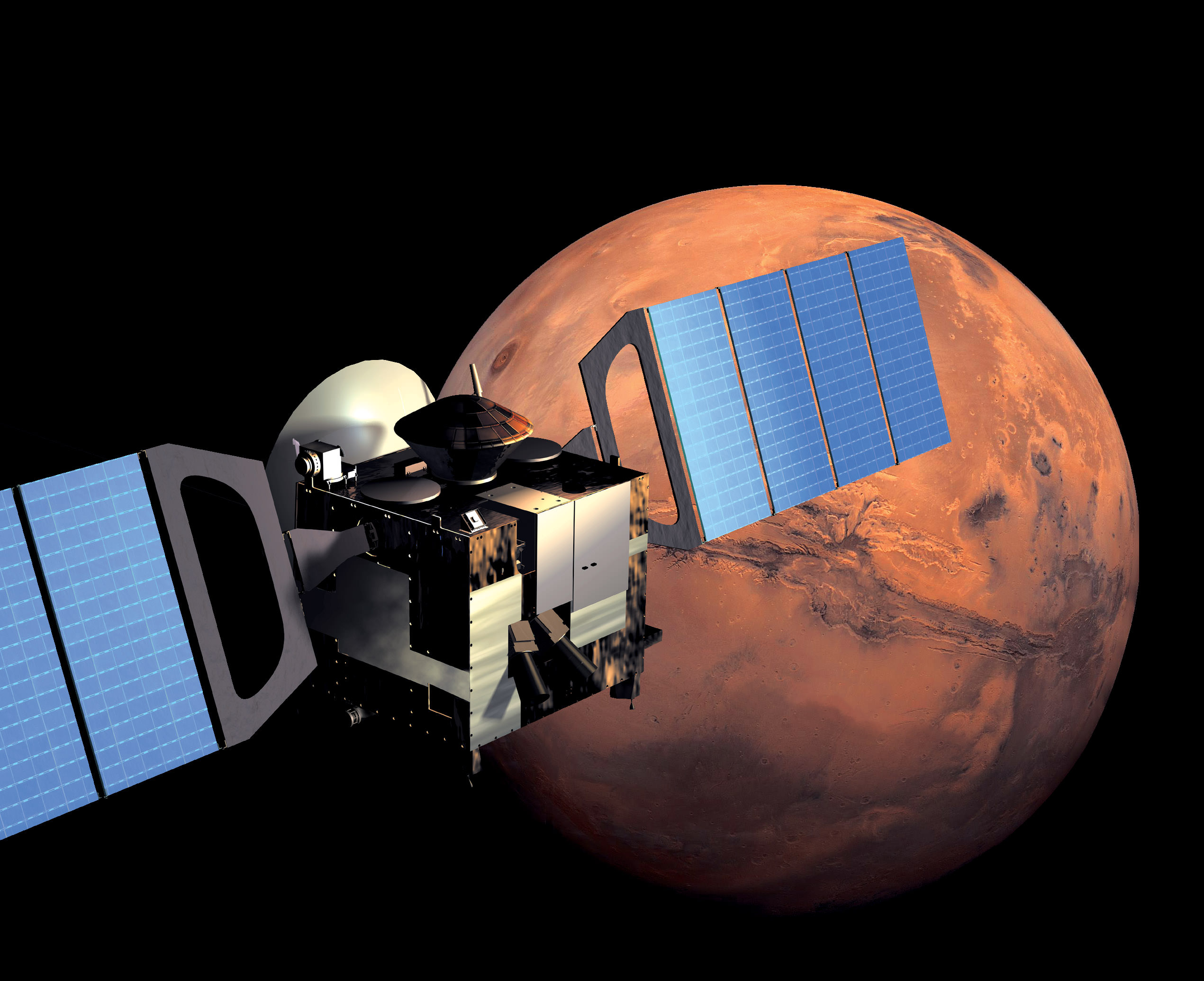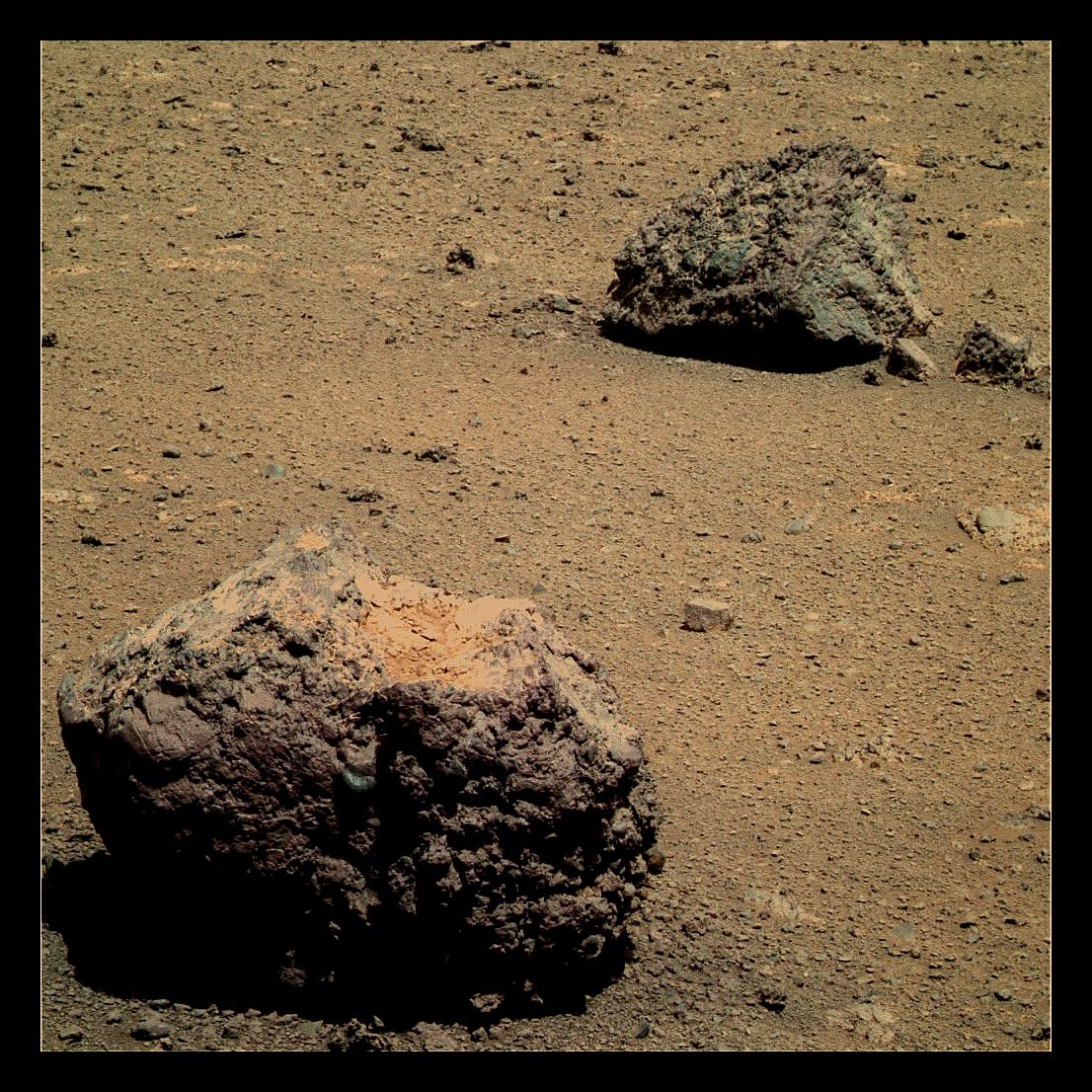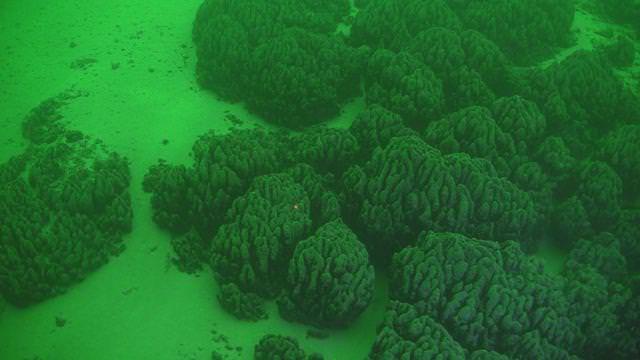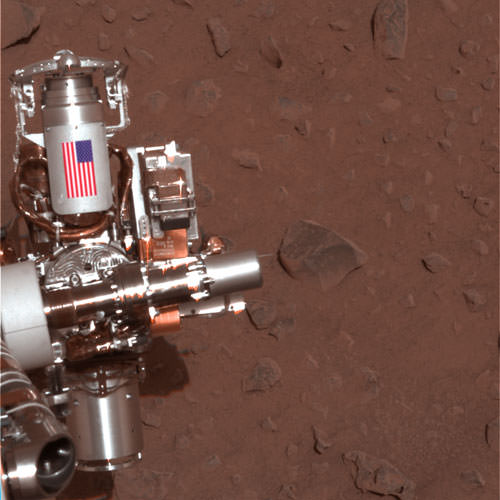Here’s a look at the Opportunity rover’s three-year trek across 20 km (13 miles) of Meridiani Planum on Mars, using the unique vantage point of the rover itself. During the drive from Victoria Crater to Endeavour Crater, rover planners captured a horizon photograph at the end of each drive. 309 images taken during the journey appear in this video.
Encapsulating Curiosity for Martian Flight Test
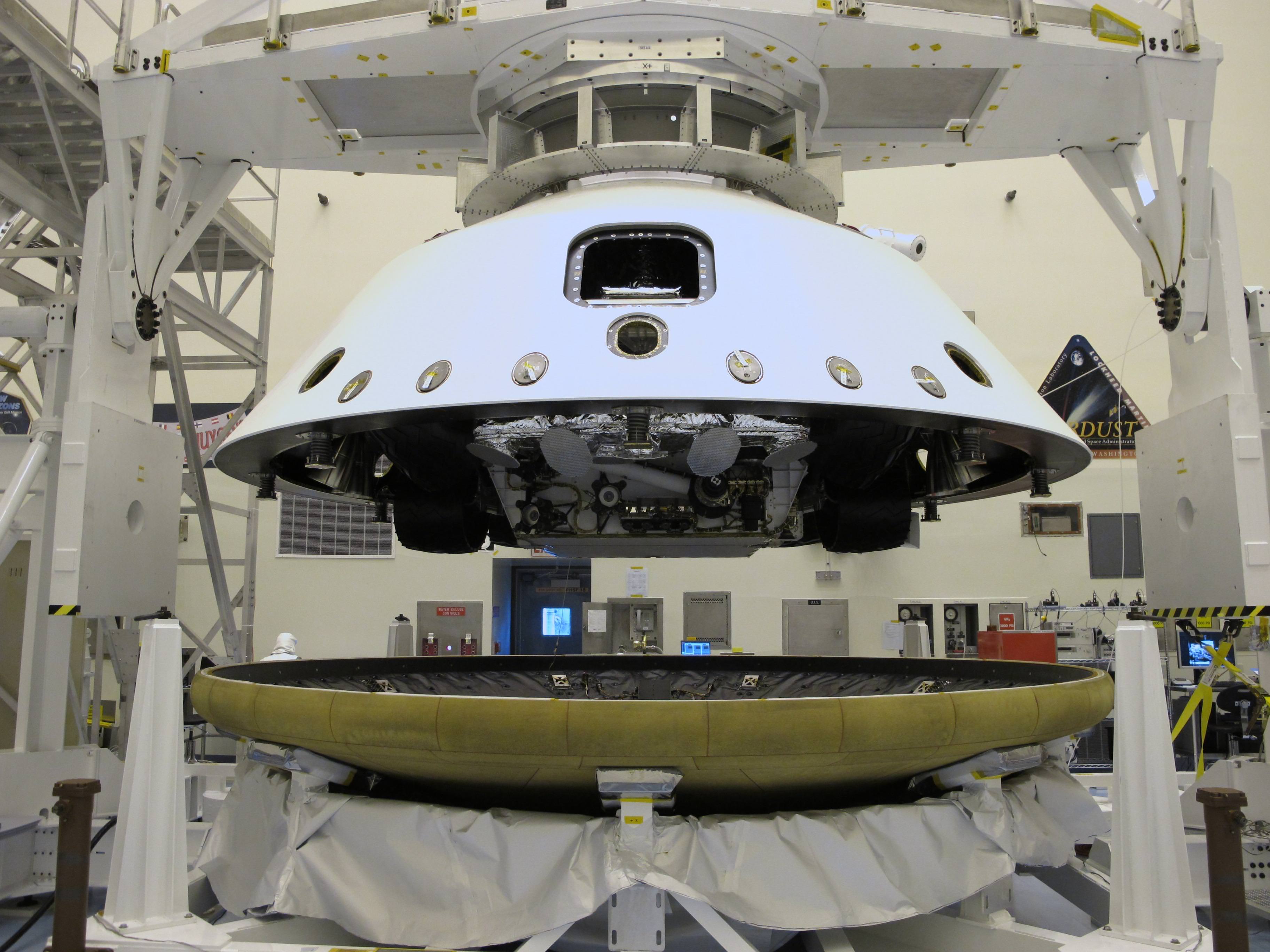
[/caption]
With just over 6 weeks to go until the liftoff of Curiosity – NASA’s next Mars rover – prelaunch processing at the Kennedy Space Center (KSC) in Florida is rapidly entering the home stretch. Technicians placed the folded rover inside the complete aeroshell to match the Martian entry configuration components together and conduct preflight testing of the integrated assembly at the Payload Hazardous Servicing Facility at KSC. The aeroshell is comprised of the heat shield and back shell and encapsulates Curiosity during the long voyage to Mars.
The job of the aeroshell is to protect the Curiosity Mars Science Laboratory (MSL) from the intense heat of several thousand degrees F(C) generated by friction as the delicate assemblage smashes into the Martian atmosphere during the terrifying entry and descent to the surface.
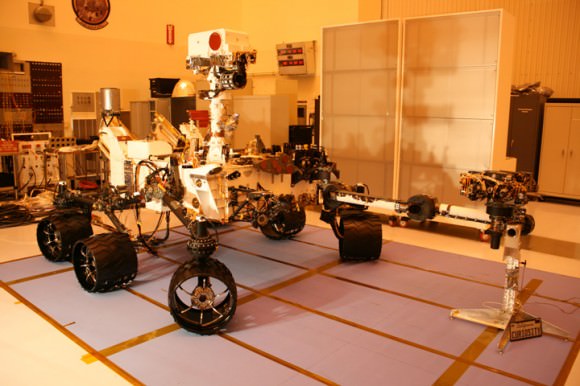
The rover itself has been mated to the back shell powered descent vehicle, known as the PDV or sky crane. The rocket powered descent stage (PDV) is designed to maneuver through the Martian atmosphere, slow the descent and safely set Curiosity down onto the surface at a precise location inside the chosen landing site of Gale Crater.
Technicians still have several more weeks of hardware testing and planetary protection checks ahead before NASA’s minivan sized Martian robot is encapsulated inside the aeroshell for the final time.
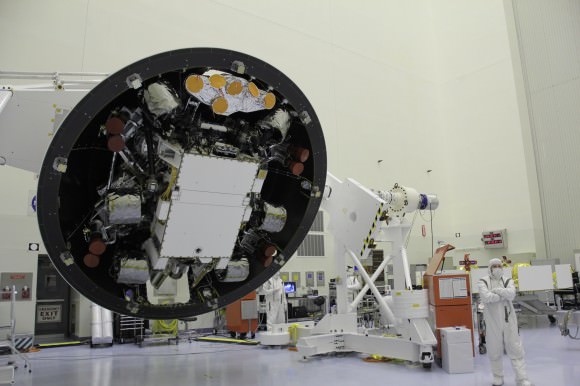
At the Payload Hazardous Servicing Facility at the Kennedy Space Center in Florida, the "back shell powered descent vehicle" configuration of NASA's Mars Science Laboratory is being rotated for final closeout actions. At this time Curiosity and its rocket-powered descent stage have already been integrated, and are now encapsulated inside the spacecraft's back shell. The configuration of rover integrated with the descent stage is the "powered descent vehicle." The back shell, a protective cover, carries the parachute and several other components used during descent. The yellow disks visible at the top of the configuration are the descent stage's radar antennas that will be used to calculate the rover's descent speed and altitude. Credit: NASA/JPL-Caltech
Another major task still to be completed is mating the aeroshell to the cruise stage and then fueling of the cruise stage, which guides MSL from the Earth to Mars, according to Guy Webster, press spokesman for NASA’s Jet Propulsion Laboratory which manages the MSL project for NASA.
The launch of the $2.5 Billion Curiosity rover atop an Atlas V rocket is slated for Nov. 25, the day after Thanksgiving, and the launch window extends until Dec. 18. Arrival at Gale crater is set for August 2012.
Curiosity is by far the most scientifically advanced surface robotic rover ever sent beyond Earth and will search for environmental conditions that could have been favorable to support Martian microbial life forms if they ever existed in the past or present.
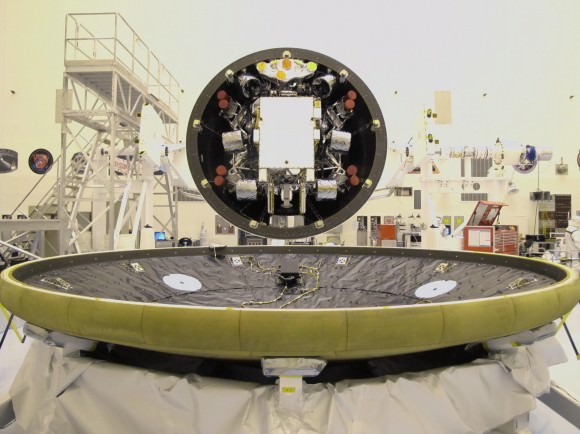
At the Payload Hazardous Servicing Facility at NASA's Kennedy Space Center in Florida, the "back shell powered descent vehicle" configuration, containing NASA's Mars Science Laboratory rover, Curiosity, is being rotated for final closeout actions. The flat, circular object in the foreground of the image is the spacecraft's heat shield. The heat shield and the back shell will together form an encapsulating aeroshell that will protect the rover from the intense heat and friction that will be generated as the flight system descends through the Martian atmosphere.Credit: NASA/JPL-Caltech
Watch for my upcoming report from inside the cleanroom with Curiosity.
Read Ken’s continuing features about Curiosity and Opportunity starting here:
Opportunity spotted Exploring vast Endeavour Crater from Mars Orbit
Twin Towers 9/11 Tribute by Opportunity Mars RoverNASA Robot arrives at ‘New’ Landing Site holding Clues to Ancient Water Flow on Mars
Opportunity Arrives at Huge Martian Crater with Superb Science and Scenic Outlook
Opportunity Snaps Gorgeous Vistas nearing the Foothills of Giant Endeavour Crater
Dramatic New NASA Animation Depicts Next Mars Rover in Action
Opportunity Rover Heads for Spirit Point to Honor Dead Martian Sister; Science Team Tributes
Martian Atmosphere Supersaturated with Water?
[/caption]
Last week, scientists announced findings based on data from the SPICAM spectrometer onboard ESA’s Mars Express spacecraft. The findings reported in Science by Maltagliati et al (2011), reveal that the Martian atmosphere is supersaturated with water vapor. According to the research team, the discovery provides new information which will help scientists better understand the water cycle and atmospheric history of Mars.
What processes are at work to allow large amounts of water vapor in the Martian atmosphere?
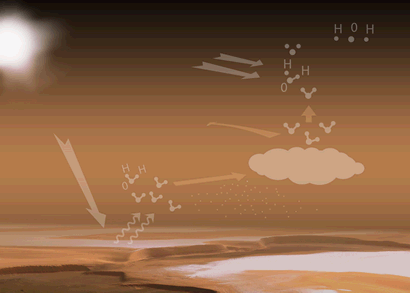 The animated sequence to the left shows the water cycle of the Martian atmosphere in action:
The animated sequence to the left shows the water cycle of the Martian atmosphere in action:
When the polar caps of Mars (which contain frozen Water and CO2) are warmed by the Sun during spring and summer, the water sublimates and is released into the atmosphere.
Atmospheric winds transport the water vapor molecules to higher altitudes. When the water molecules combine with dust molecules, clouds are formed. If there isn’t much dust in the atmosphere, the rate of condensation is reduced, which leaves water vapor in the atmosphere, creating a supersaturated state.
Water vapor may also be transported by wind to the southern hemisphere or may be carried high in the atmosphere.In the upper atmosphere the water vapor can be affected by photodissociation in which solar radiation (white arrows) splits the water molecules into hydrogen and oxygen atoms, which then escape into space.
Scientists had generally assumed that supersaturation cannot exist in the cold Martian atmosphere, believing that any water vapor in excess of saturation instantly froze. Data from SPICAM revealed that supersaturation takes place at altitudes of up to 50 km above the surface when Mars is at its farthest point from the Sun.
Based on the SPICAM data, scientists have learned that there is more water vapor in the Martian atmosphere than previously believed. While the amount of water in Mars’ atmosphere is about 10,000 times less water vapor than that of Earth, previous models have underestimated the amount of water in the Martian atmosphere at altitudes of 20-50km, as the data suggests 10 to 100 times more water than expected at said altitudes.
“The vertical distribution of water vapour is a key factor in the study of Mars’ hydrological cycle, and the old paradigm that it is mainly controlled by saturation physics now needs to be revised,” said Luca Maltagliati, one of the authors of the paper. “Our finding has major implications for understanding the planet’s global climate and the transport of water from one hemisphere to the other.”
“The data suggest that much more water vapour is being carried high enough in the atmosphere to be affected by photodissociation,” added Franck Montmessin, Principal Investigator for SPICAM and co-author of the paper.
“Solar radiation can split the water molecules into oxygen and hydrogen atoms, which can then escape into space. This has implications for the rate at which water has been lost from the planet and for the long-term evolution of the Martian surface and atmosphere.”
However, water vapour is a very dynamic trace gas, and one of the most seasonally variable atmospheric constituents on Mars.
Source: ESA/Mars Express Mission Updates
Were Martian Rocks Weathered by Water?
[/caption]
There are many ways rocks can be textured. Wind erosion, water erosion, the escape of volcanic gases during their formation (in the case of igneous rocks)… all these forces can create the pitted textures found on many rocks on Earth… and perhaps even on Mars. And according to a report published by a group of planetary geologists led by James Head of Rhode Island’s Brown University, another method may also be at play on Mars: melting snow.
Here on Earth in the hyper-arid dry valleys of Antarctica, water from melting snow erodes the surfaces of dark boulders, creating pitted textures similar to what has been found at many locations on Mars.
In order for that process to be truly analogous, though, a few conditions would have to be met on the red planet. First, the atmospheric pressure must be high enough to allow water to remain – if only temporarily – in a liquid state. Water that instantly boils away won’t have enough time to chemically attack the rock. Second, the rock itself must be at least warm enough to not freeze the water (again, must be liquid.) And third, there must actually be water, snow or frost present.
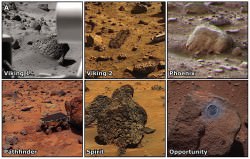 While one or more of these factors may be currently present in locations on Mars, they have not yet been found to exist all together in the same place. But that’s just what’s been found now… in Mars’ geologic past these may all have very well existed either in isolated locations or perhaps even planet-wide.
While one or more of these factors may be currently present in locations on Mars, they have not yet been found to exist all together in the same place. But that’s just what’s been found now… in Mars’ geologic past these may all have very well existed either in isolated locations or perhaps even planet-wide.
The paper’s abstract states:
For example, increases in atmospheric water vapor content (due, for example, to the loss of the south perennial polar CO2 cap) could favor the deposition of snow, which if collected on rocks heated to above the melting temperature during favorable conditions (e.g., perihelion), could cause melting and the type of locally enhanced chemical weathering that can cause pits.
In other words, if the dry ice at Mars’ south pole had melted at one point, freed-up water vapor could have fallen on rocks elsewhere as snow. If Mars were at a point in its orbit closest to the Sun and therefore experiencing warmer temperatures the snow could have then melted – especially upon darker rock surfaces.
Still, it’s possible – or even probable – that the weathering did not occur at a consistent rate across the entire surface of the rocks. Some sides may have weathered faster or slower than others, depending on how they were exposed to the elements. But if there’s one thing Mars has had a surplus of, it’s time. Even if the processes outlined in the report are indeed the cause of Mars’ pitted rocks, they have likely been in play over many hundreds of millions – even billions – of years.
Read the team’s report on the Journal of Geophysical Research here.
Thanks to Stu Atkinson for his color work on the images from Opportunity. Check out his blog The Road to Endeavour for updates on the rover’s progress.
Citizen Science: Help Find Life on Mars
[/caption]
Interested in helping NASA scientists pinpoint where to look for signs of life on Mars?
If so, you can join a new citizen science website called MAPPER, launched in conjunction with the Pavilion Lake Research Project’s 2011 field season.
How can the MAPPER and Pavilion Lake Research projects help scientists look for off-Earth life?
Since 2008, the Pavilion Lake Research Project (PLRP) has used DeepWorker submersible vehicles to investigate the underwater environment of two lakes in Canada (Pavilion and Kelly). With the MAPPER project, citizen scientists can work with NASA scientists and explore the lake bottoms from the view of a DeepWorker pilot.
The PLRP team’s main area of focus are freshwater carbonate formations known as microbialites. By studying microbialites that thrive in Pavilion and Kelly Lake, the scientists believe a better understanding of how the formations develop. Through a greater understanding of the carbonate formations, the team believes they will gain deeper insights into where signs of life may be found on Mars and beyond.
To investigate the formations in detail, video footage and photos of the lake bottom are recorded by DeepWorker sub pilots. The data requires analysis in order to determine what types of features can be found in different parts of the lake. Analyzing the data allows the team to answer questions such as; “how does microbialite texture and size vary with depth?” and “why do microbialites grow in certain parts of the lake but not in others?”.
The amount of data to analyze is staggering – if each image taken were to be printed, the stack would be taller than the depth of Pavilion Lake (over 60 meters). If each image were reviewed one-by-one, the PLRP’s team would never be able to complete their work. Distributing the work to the general public solves the problem, due in part by spreading the massive work out over many volunteers across the Internet.
Since the PLRP 2011 field season Morphology Analysis Project for Participatory Exploration and Research (MAPPER) MAPPER has been open to the general public. By opening MAPPER to the public, anyone can explore Pavilion and Kelly Lake as full-fledged members of PLRP’s Remote Science Team.
So how do volunteers use MAPPER to help the PLRP team?
Once volunteers create an account at: getmapper.com, the volunteers complete a brief tutorial, which provides the necessary training to tag photos in the PLRP dataset. MAPPER has ease-of-use in mind, providing users with a simple interface, which makes tagging features like sediment, microbialites, rocks, and algae easy. In case a user is unsure of how to tag a photo, examples and descriptions of each feature are available.
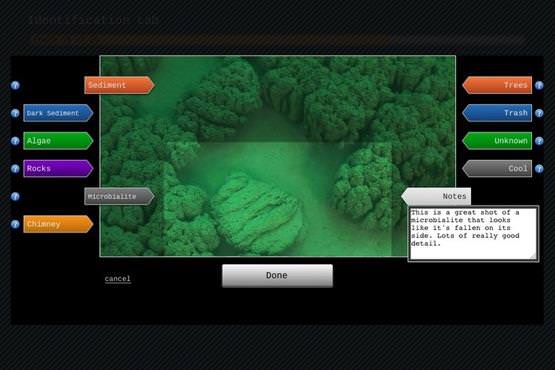
In a manner similar to online games, each photo tagged earns the volunteer points which can be used to unlock new activities. Volunteers can also compete with other Remote Science Team members on the MAPPER leaderboard. Volunteers can also check to see how close each dataset is to being completely reviewed and see how much they have contributed to said dataset, as well as seeing what features have been tagged the most. Volunteers who tag a photo as ‘cool’ save said image to their Cool Photos album, allowing them to easily find the image at a later date.
PLRP Remote Science Team members from across North America, Europe and Asia have already been making discoveries in Pavilion and Kelly Lake. If you’d like to become a PLRP Remote Science Team member, visit: www.getmapper.com
You can also learn more by visiting the MAPPER Facebook page
Opportunity spotted Exploring vast Endeavour Crater from Mars Orbit
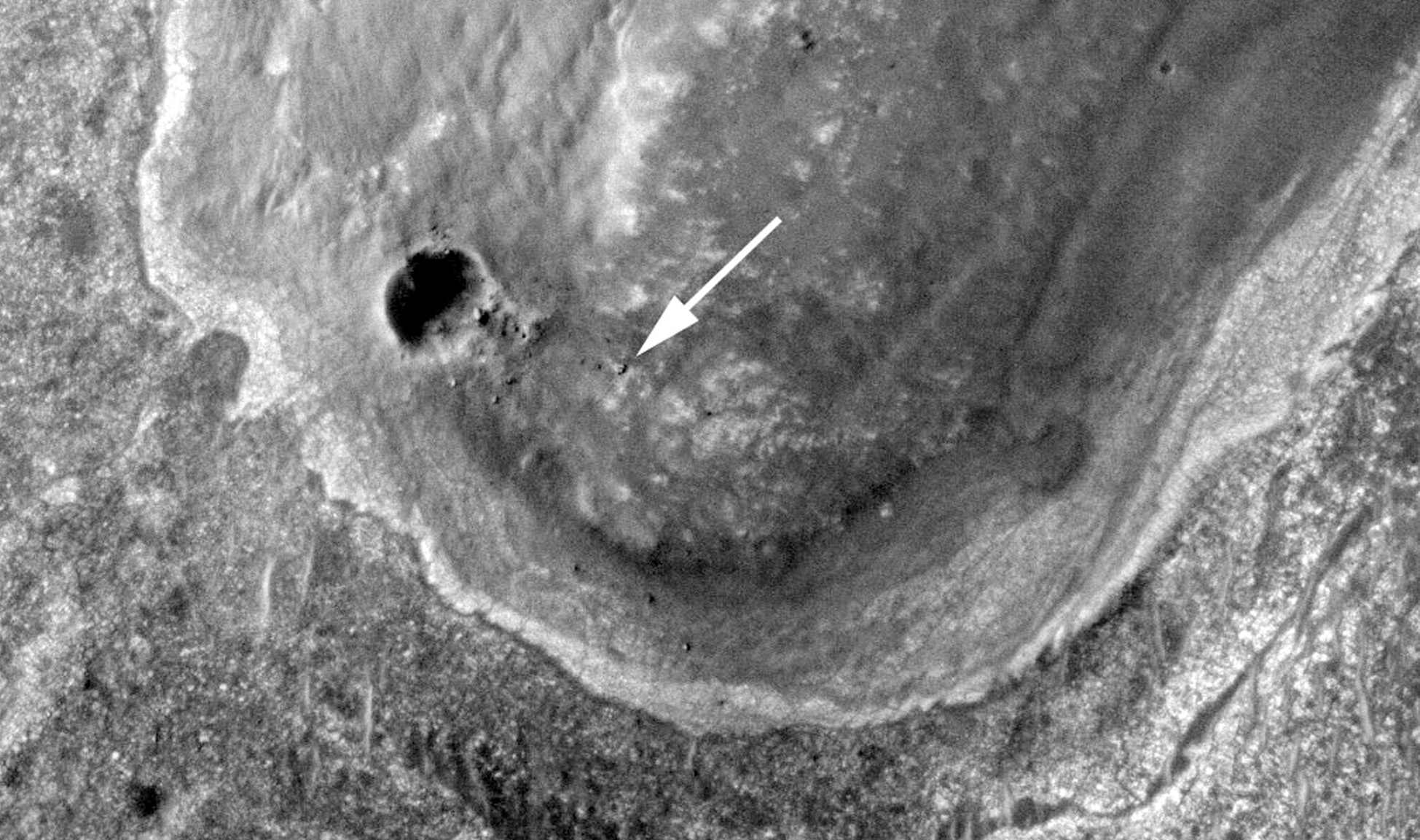
[/caption]
Opportunity has just been imaged in high resolution at Endeavour crater by a powerful NASA camera orbiting overhead in Mars orbit. The new image (see above) was snapped while NASA’s long lived robot was climbing a hilltop offering spectacular panoramic vistas peering into the vast crater which is some 14 miles (22 km) wide.
The HiRiSE camera aboard NASA’s Mars Reconnaissance Orbiter photographed Opportunity and her wheel tracks on September 10, 2011, or Martian Sol 2712 for a mission warrentied to last only 90 Sols ! The rover is sitting to the right of another small crater known as Odyssey. Click to enlarge the image.
Look very closely and you’ll even be able to easily discern the rovers pair of tire tracks showing the path traversed by the robot as she explores the crater and the ejecta rocks and boulders excavated and strewn about by an ancient impact.
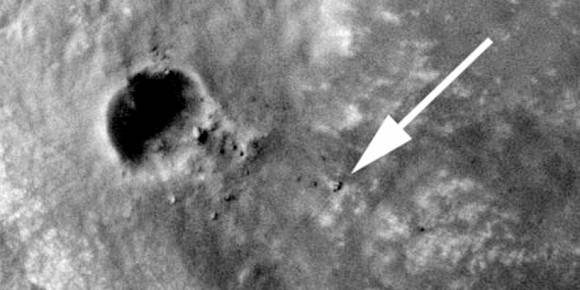
Opportunity is ascending up the rim of Endeavour crater at the southern tip of a low ridge dubbed Cape York – a location that has already yielded a bonanza of new science data since her recent arrival in August 2011 after a more than 20 mile (33 km) epic trek.
The intrepid rover discovered a rock unlike any other since she safely landed at the Meridiani Planum region of Mars nearly eight years ago on Jan. 24, 2004.
Opportunity is now searching Endeavour crater and Cape York for signatures of phyllosilicates – clay minerals that formed in the presence of pH neutral water flowing on Mars surface billions of years ago.
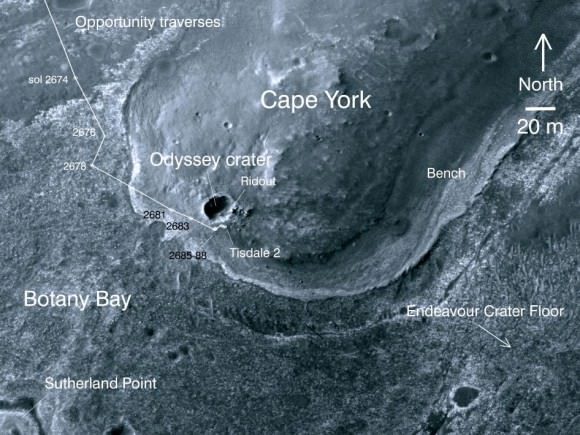
This image taken from Mars orbit shows the path driven by NASA's Mars Exploration Rover Opportunity in the weeks around the rover's arrival at the rim of Endeavour crater and up to Sol 2688. Opportunity has since driven a short distance to the right. Credit: NASA/JPL-Caltech/University of Arizona
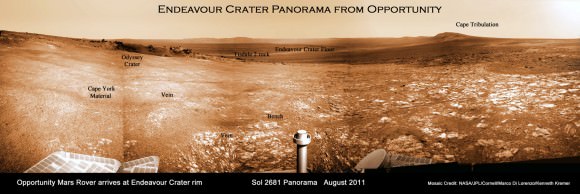
Opportunity arrived at the rim of Endeavour on Sol 2681, August 9, 2011 and climbed up the ridge known as Cape York. Odyssey crater is visible at left. Opportunity has since driven a short distance beyond Odyssey crater and was photographed from Mars orbit on Sept. 10, 2011.
Mosaic Credit: NASA/JPL/Cornell/Marco Di Lorenzo/Kenneth Kremer
Read Ken’s continuing features about Curiosity and Opportunity starting here:
Opportunity spotted Exploring vast Endeavour Crater from Mars Orbit
Twin Towers 9/11 Tribute by Opportunity Mars Rover
NASA Robot arrives at ‘New’ Landing Site holding Clues to Ancient Water Flow on Mars
Opportunity Arrives at Huge Martian Crater with Superb Science and Scenic Outlook
Opportunity Snaps Gorgeous Vistas nearing the Foothills of Giant Endeavour Crater
Dramatic New NASA Animation Depicts Next Mars Rover in Action
Opportunity Rover Heads for Spirit Point to Honor Dead Martian Sister; Science Team Tributes
Twin Towers 9/11 Tribute by Opportunity Mars Rover
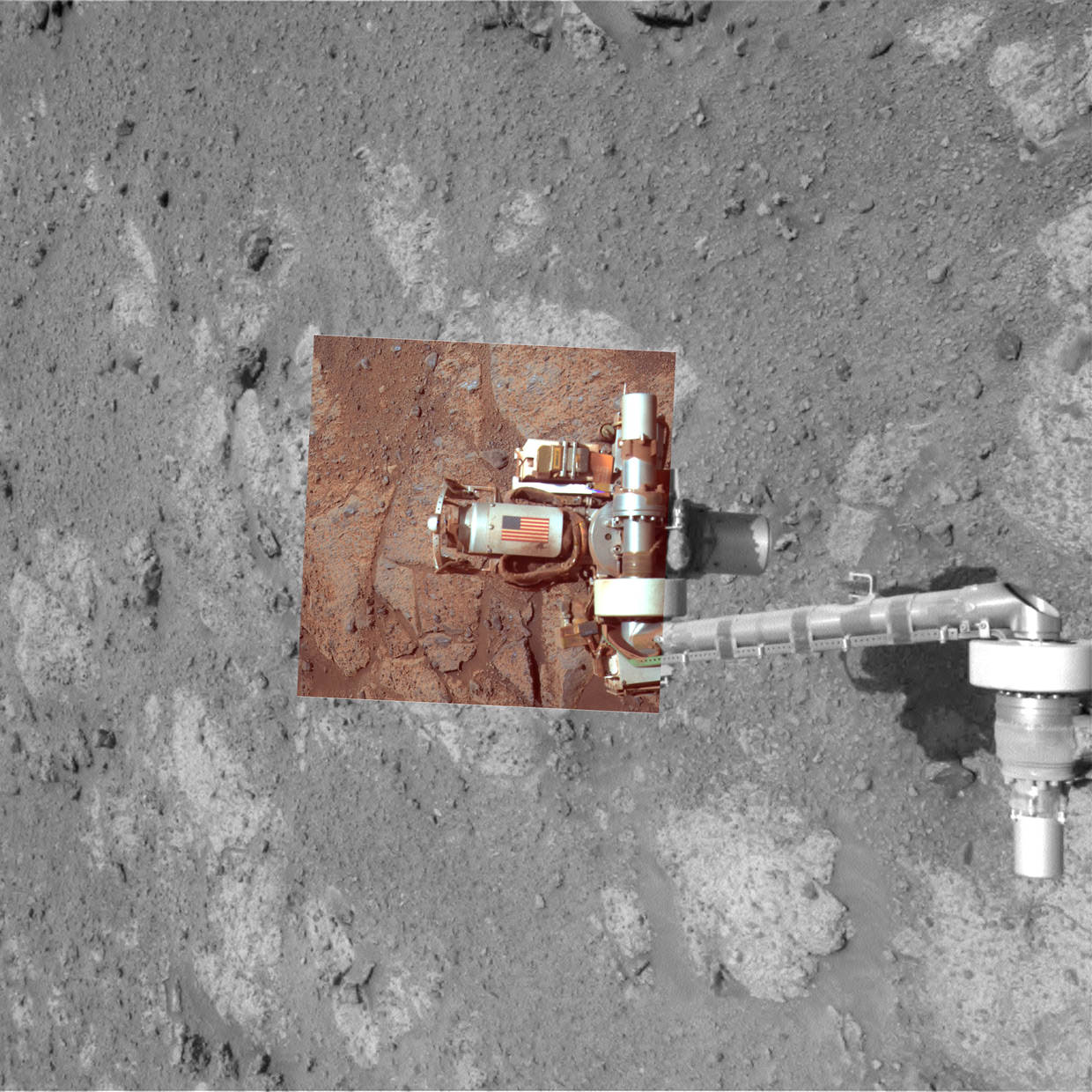
[/caption]
On this somber occasion marking the 10th anniversary of the tragic events of 9/11, NASA’s Opportunity Mars rover has taken new images of itself on 9/11/11 showing a piece of metal recovered from the wreckage of the Twin Towers of the World Trade Center in New York City that was carried all the way to the planet Mars as a commemorative memorial to the innocent victims of the terrorist attacks of Sept 11, 2001.
On Sept. 11, 2011 (Martian Sol 2713), Opportunity snapped the memorial image above showing the Rock Abrasion Tool (RAT) and an American Flag – evoking the memory of the Twin Towers – from a slope on a Martian hill named Cape York which in turn is a segment of the rim of a gigantic crater named Endeavour.
Opportunity is still roving the red planet’s surface, nearly 8 years after safely landing on Jan 24, 2004. After an epic trek she recently arrived at the gigantic 14 mile wide Endeavour crater .
Opportunity took the new image of the RAT and 9/11 US Flag memorial on Mars on the exact day timed to coincide with the 10th anniversary of the attacks.
The image shows the arm extended for inspection of target on a rock called “Chester Lake”, according to NASA officials. Opportunity is driving in a northerly direction up the Cape York hill on her scientific expedition of the crater’s rim.
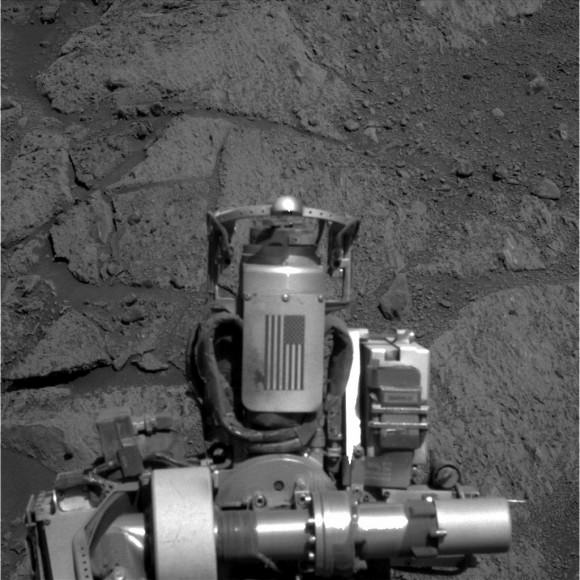
Close-up image taken on 9/11/11 of a piece of metal with the American flag on it of a NASA’s Opportunity rover on Mars is made of aluminum recovered from the site of the World Trade Center towers in the weeks after their destruction on Sept. 11, 2001. Credit: NASA/JPL-Caltech/Cornell University/Arizona State University
Both towers of the World Trade Center in New York City were destroyed by the terrorists on that terrible day and nearly 3000 precious people were killed during horrifying historic events that changed America and the World forever.
The RAT was built for NASA and both rovers by Honeybee Robotics which at that time was located less than a mile away from the WTC near the southern tip of Manhattan.
Steve Gorevan, the founder and chairman of Honeybee and a member of the rover science team, told me in a past interview that he was on his way to work and out on the city streets within a few blocks of the Twin Towers when he suddenly heard the sounds of the jet engines just before the first tower was struck.
Gorevan and the Honeybee employees watched the tragic events unfold from their company’s offices and rooftop the rest of the day. Following the terror attacks, Gorevan said access to Honeybee was restricted for weeks and the firm was on a tight deadline to deliver the RAT’s to NASA and the Jet Propulsion Laboratory in California where the rovers were being assembled.
The idea for somehow placing a Martian memorial on the rovers was presented. Gorevan told me that he was able to secure metallic pieces from the WTC wreckage through the Office of the then NYC Mayor Rudy Guiliani a few weeks after the attacks.

Aluminum shards were delivered by the Mayor’s office to Honeybee along with a note indicating their authenticity. These were soon fashioned into an aluminum shield that was placed on each RAT along with a US Flag. The shield serves as a cable guard.
Gorevan says the twin towers memorial was purposely kept quiet for some time until well after both rovers landed out of respect for the victims’ families.
Opportunity is healthy and continuing her exploration of Endeavour crater which harbors geologic formations and rocks unlike any previously investigated by either of the Mars Exploration (MER) rovers.
Along the rim of Endeavour crater rover scientists hope to discover and analyze clay minerals which formed in pH neutral water billions of years ago and a habitable environment much more favorable to the formation of life compared to all the other spots studied by either rover thus far.
Both rovers far exceeded their original 90 days warranties with many years of added bonus time for science exploration.
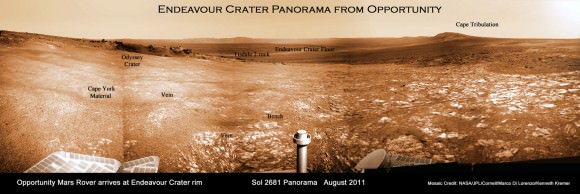
Opportunity arrived at the rim of Endeavour on Sol 2681, August 9, 2011 and climbed up the ridge known as Cape York. Odyssey crater is visible at left. Opportunity drove north from here to snap a new 9/11 memorial image on Sept 11, 2011 marking the 10th anniversary of the 9/11 terrorist attacks.
Mosaic Credit: NASA/JPL/Cornell/Marco Di Lorenzo/Kenneth Kremer
Read Ken’s continuing features about Mars starting here
NASA Robot arrives at ‘New’ Landing Site holding Clues to Ancient Water Flow on Mars
Opportunity Arrives at Huge Martian Crater with Superb Science and Scenic Outlook
Opportunity Snaps Gorgeous Vistas nearing the Foothills of Giant Endeavour Crater
Dramatic New NASA Animation Depicts Next Mars Rover in Action
Opportunity Rover Heads for Spirit Point to Honor Dead Martian Sister; Science Team Tributes
Opportunity Rover Completes Exploration of fascinating Santa Maria Crater
Opportunity Surpasses 30 KM Driving and Snaps Skylab Crater in 3 D
A Martian Memorial to 9/11
As we approach the tenth anniversary of the September 11 World Trade Center attacks (has it already been ten years??) countless hearts and minds will be remembering the fateful day our world changed forever, and the many people who tragically lost their lives in the catastrophic collapse of the twin towers. Memorial events will be held in many locations around the world… and even, in a small yet poignant way, on another world. For, unknown to many, two pieces of the World Trade Center are on the surface of Mars: one affixed to the rover Spirit which sits silently in its permanent position near a small plateau called “Home Plate” and the other on its sister rover Opportunity, currently exploring the rim of the vast Endeavour crater.
Much more than scientific exploration tools, these rovers are also interplanetary memorials to the victims of 9/11.
In September of 2001 workers at Honeybee Robotics in lower Manhattan were busy preparing the Rock Abrasion Tools that the twin rovers Spirit and Opportunity would each be equipped with, specialized instruments that would allow scientists to study the interiors of Martian rocks. After the World Trade Center attacks occurred, the company wanted a way to memorialize those who had lost their lives.
Through what was undoubtedly some incredibly skillful use of contacts, Honeybee founder and MER science team member Stephen Gorevan – on a suggestion by JPL engineer Steve Kondos and with help from the NYC mayor’s office and rover mission leader Steve Squyres – was able to procure two pieces of aluminum from the tower debris. These were fashioned into cylindrical cable shields by a contracted metal shop in Round Rock, Texas, and had American flags adhered to each by Honeybee engineer Tom Myrick.
The rovers were launched in the summer of 2003 and have both successfully operated on Mars many years past their planned initial mission timelines. Spirit currently sits silent, having ceased communication in March 2010, but Opportunity is still going strong in its exploration of the Martian surface.
“It’s gratifying knowing that a piece of the World Trade Center is up there on Mars. That shield on Mars, to me, contrasts the destructive nature of the attackers with the ingenuity and hopeful attitude of Americans.”
– Stephen Gorevan, Honeybee Robotics founder and chairman
The image above, taken in 2004, shows the cable shield with American flag on the Rock Abrasion Tool attached to Spirit.
These memorials will remain on Mars long after both rovers have ceased to run, subtle memorials to thousands of lives and testaments to our ability to forge ahead in the name of hopefulness and discovery.
Read the full story by Keith Cowing on OnOrbit.com.
Image credit: NASA / JPL-Caltech
Meals for Mars?
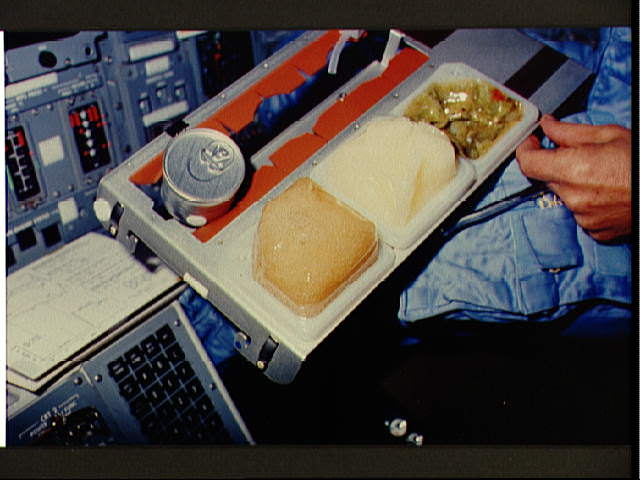
[/caption]
NASA has made tremendous progress during the past fifty years with regards to food science. Gone are the days of nutrients in toothpaste style tubes and it’s safe to assume NASA astronauts haven’t had to drink Tang in decades.
At a recent meeting of the American Chemical Society, Maya R. Cooper, senior research scientist at NASA’s Space Food Systems Laboratory discussed how feeding astronauts will be one of the most difficult issues to resolve before launching a manned mission to Mars.
Despite all the progress NASA has made, what challenges still need to be overcome to feed the crew of a manned mission to Mars?
When we plan a camping trip, not much thought is given to what will be eaten during a weekend, a week, or even a month’s time. Modern food science has given us products that are safe to eat after even weeks, and in some cases months. It is very easy to go to the store and load up on delicious and nutritious food, with the expectation that said food will be relatively safe to eat with minor concerns for safety.
Manned spaceflight however, isn’t your average camping trip. Even during a one to two week mission, NASA astronauts can’t just open a refrigerator and make themselves a cold-cut sandwich. Food scientists at NASA must specially prepare meals for astronauts in order to ensure said meals are safe to consume during the mission, not only for the crew, but for their habitat as well. The average can or bottle of pop wouldn’t provide the same level of safety and satisfaction for a crew in space as it would for a person on Earth. Food crumbs can clog air filters or become lodged into sensitive equipment. Basically, what works well for a camping trip doesn’t always work for an ISS mission and what works for the ISS crew may not work for a multi-year mission to Mars.
In her talk, Cooper discussed some of the issues such as food safety that she and her team currently address. Some of the other issues discussed included food packaging, nutrition, weight, and of course variety.
Cooper cited that the current daily allocation of food for manned spaceflight crews is just under four pounds per day. Estimating a five-year trek to Mars would require over 7,000 pounds of food per crew person. “That’s a clear impediment to a lot of mission scenarios,” Cooper said. “We need new approaches. Right now, we are looking at the possibility of implementing a bioregenerative system that would involve growing crops in space and possibly shipping some bulk commodities to a Mars habitat as well. This scenario involves much more food processing and meal preparation than the current food system developed for the space shuttles and the International Space Station.”
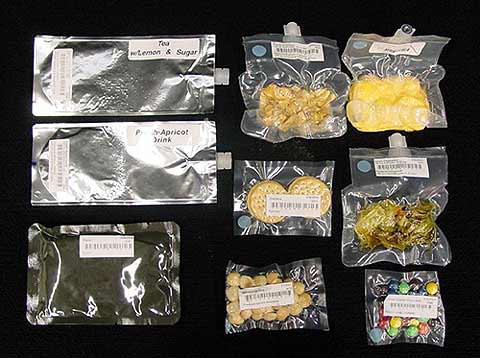
Image Credit: NASA/Johnson Space Flight Center
The idea behind bioregenerative systems is that plants could multi-task, not only providing food, but also removing carbon dioxide gas and releasing oxygen, just like plants on Earth. Plants that are prime candidates for a Mars mission would have very little inedible structure. So far, ten plants that require little room and grow with minimal work have been identified. A few of the ten ideal plants identified are lettuce, spinach, carrots, tomatoes, strawberries, some herbs and cabbage.
One other idea Cooper suggested for future manned missions to Mars, would be to ship food products ahead of time. Sending supplies in advance of a mission would result in less food and packaging flying onboard the manned spacecraft headed to Mars. There are a few questions regarding sending supplies in advance, namely what happens if a critical supply ship fails to reach Mars and whether current food preservation technology can guarantee adequate nutritional content for a mission to Mars.
“The NASA Advanced Food Technology project is currently working to address the issues of food variety, weight, volume, nutrition and trash disposal through research and external academic and commercial collaborations,” Cooper noted.
Source: American Chemical Society
Ray Sanders is a Sci-Fi geek, astronomer and space/science blogger. Visit his website Dear Astronomer and follow on Twitter (@DearAstronomer) or Google+ for more space musings.
NASA Robot arrives at ‘New’ Landing Site holding Clues to Ancient Water Flow on Mars
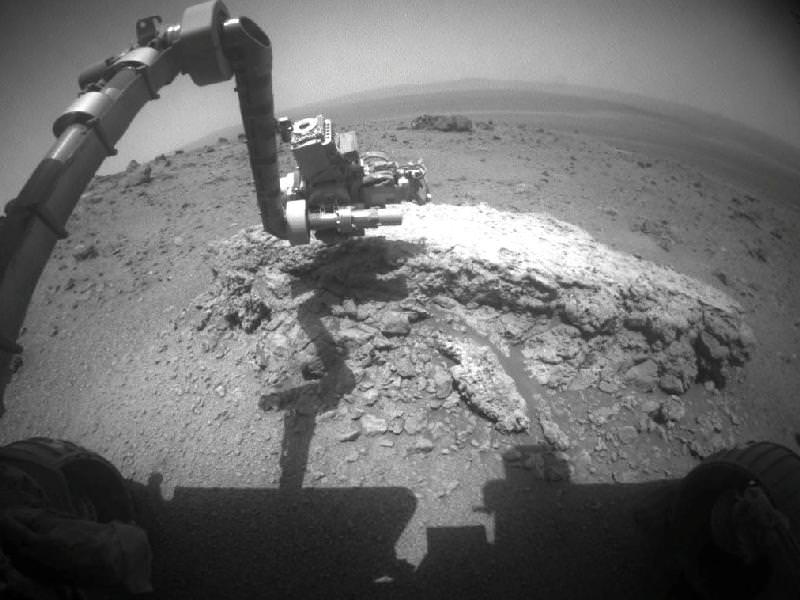
[/caption]
Opportunity has begun a whole new mission at the vast expanse of Endeavour Crater promising a boatload of new science discoveries.
Scientists directing NASA’s Mars Opportunity rover gushed with excitement as they announced that the aging robot has discovered a rock with a composition unlike anything previously explored on the Red Planet’s surface – since she landed on the exotic Martian plains 7.5 years ago – and which offers indications that liquid water might have percolated or flowed at this spot billions of years ago.
Barely three weeks ago Opportunity arrived at the rim of the gigantic 14 mile ( 22 km) wide crater named Endeavour after an epic multi-year trek, and for the team it’s literally been like a 2nd landing on Mars – and the equivalent of the birth of a whole new mission of exploration at an entirely ‘new’ landing site.
“This is like having a brand new landing site for our veteran rover,” said Dave Lavery, program executive for NASA’s Mars Exploration Rovers at NASA Headquarters in Washington. “It is a remarkable bonus that comes from being able to rove on Mars with well-built hardware that lasts.”
Opportunity has traversed an incredible distance of 20.8 miles (33.5 km) across the Meridiani Planum region of Mars since landing on January 24, 2004 for a 3 month mission – now 30 times longer than the original warranty.
“Tisdale 2” is the name of the first rock that Opportunity drove to and investigated after reaching Endeavour crater and climbing up the rim at a low ridge dubbed ‘Cape York’.
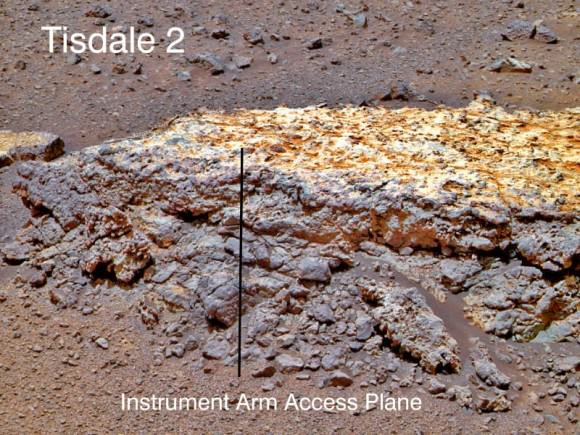
Endeavour’s rim is heavily eroded and discontinuous and divided into a series of segmented and beautiful mountainous ridges that offer a bonanza for science.
“This is not like anything we’ve ever seen before. So this is a new kind of rock.” said Steve Squyres, principal investigator for Opportunity at Cornell University in Ithaca, N.Y at a briefing for reporters on Sept. 1.
“It has a composition similar to some volcanic rocks, but there’s much more zinc and bromine than we’ve typically seen. We are getting confirmation that reaching Endeavour really has given us the equivalent of a second landing site for Opportunity.”
Tisdale 2 is a flat-topped rock about the size of a footstool that was blasted free by the impact that formed the tennis court sized “Odyssey” crater from which it was ejected.
“The other big take-away message, and this is to me the most interesting thing about Tisdale, is that this rock has a huge amount of zinc in it, way more zinc than we have ever seen in any Martian rock. And we are puzzling, we are thinking very hard over what that means,” Squyres speculated.
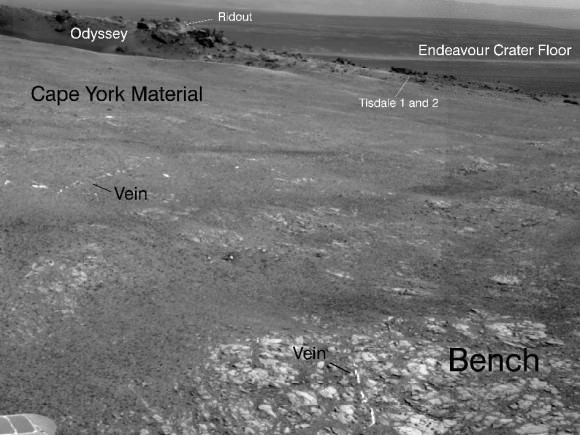
Squyres said that high levels of zinc and bromine on Earth are often associated with rocks in contact with flowing water and thus experiencing hydrothermal activity and that the impact is the source of the water.
“When you find rocks on Earth that are rich in zinc, they typically form in a place where you had some kind of hydrothermal activity going on, in other words, you have water that gets heated up and it flows through the rocks and it can dissolve out and it can get redeposited in various places,” Squyres explained.
“So this is a clue, not definitive proof yet, but this is a clue that we may be dealing with a hydrothermal system here, we may be dealing with a situation where water has percolated or flowed or somehow moved through these rocks, maybe as vapor, maybe as liquid, don’t know yet.”
“But it has enhanced the zinc concentration in this rock to levels far in excess of anything we’ve ever seen on Mars before. So that’s the beginning of what we expect is going to be a long and very interesting story about these rocks.”
Endeavour crater was chosen three years ago as the long term destination for Opportunity because it may hold clues to a time billions and billions of years ago when Mars was warmer and wetter and harbored an environment that was far more conducive to the formation of life beyond Earth.
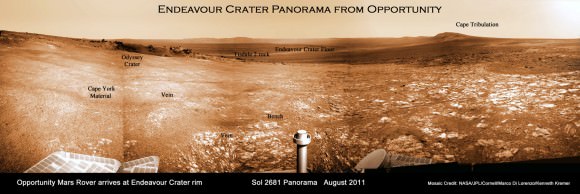
Opportunity arrived at the rim of Endeavour on Sol 2681, August 9, 2011 and climbed up the ridge known as Cape York. Odyssey crater is visible at left. The rover has driven to Tisdale 2 rock at the outskirts of Odyssey to investigate the ejecta blocks which may hold clues to ancient water flow on Mars. Distant portions of Endeavour’s rim - as far as 13 miles away – visible in the background. The rover will likely drive eventually to the Cape Tribulation rim segment at right which holds a mother lode of clay minerals. This photo mosaic was stitched together from raw images taken by Opportunity on Sol 2681.
Mosaic Credit: NASA/JPL/Cornell/Marco Di Lorenzo/Kenneth Kremer
Signatures of clay minerals, or phyllosilicates, were detected at several spots at Endeavour’s western rim by observations from the Compact Reconnaissance Imaging Spectrometer for Mars (CRISM) aboard NASA’s Mars Reconnaissance Orbiter (MRO).
“The motherlode of clay minerals is on Cape Tribulation. The exposure extends all the way to the top, mainly on the inboard side,” said Ray Arvidson, the rover’s deputy principal investigator at Washington University in St. Louis.
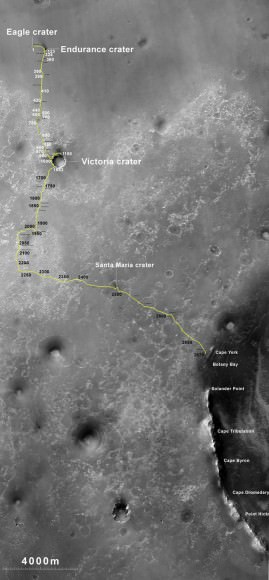
Phyllosilicates are clay minerals that form in the presence of pH neutral water and which are far more hospitable to the possible genesis of life compared to the sulfate rich rocks studied in the more highly acidic aqueous environments examined by both the Opportunity and Spirit rovers thus far.
“We can get up the side of Cape Tribulation,” said Arvidson. It’s not unlike Husband Hill for Spirit. We need to finish up first at Cape York, get through the martian winter and then start working our way south along Solander Point.
The general plan is that Opportunity will probably spend the next several months exploring the Cape York region for before going elsewhere. “Just from Tisdale 2 we know that we have something really new and different here,” said Squyres.
“On the final traverses to Cape York, we saw ragged outcrops at Botany Bay unlike anything Opportunity has seen so far, and a bench around the edge of Cape York looks like sedimentary rock that’s been cut and filled with veins of material possibly delivered by water,” said Arvidson. “We made an explicit decision to examine ancient rocks of Cape York first.”
So far at least the terrain at Cape York looks safe for driving with good prospects for mobility.
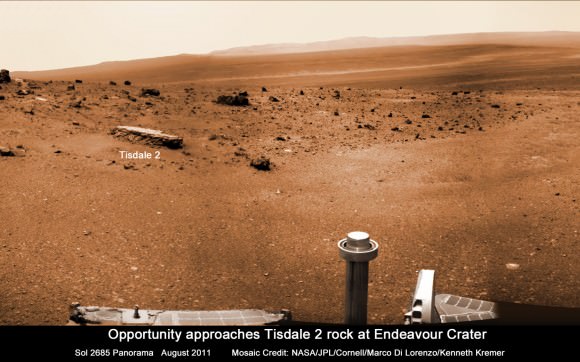
Opportunity Mars rover climbed up the ridge known as Cape York and drove to the flat topped Tisdale 2 rock at upper left to analyze it with the science instruments on the robotic arm. This photo mosaic was stitched together from raw images taken by Opportunity on Sol 2685, August 2011.
Mosaic Credit: NASA/JPL/Cornell/Marco Di Lorenzo/Kenneth Kremer
“The good news is that, as predicted, we have hard packed soils like the plains at Gusev that Spirit saw before getting to the Columbia Hills,” said Arvidson. “The wheel tracks at Cape York are very, very shallow. So if anything we will have some skid going downhill the slopes of 5 to 10 degrees on the inboard side which we can correct for.”
“We are always on the lookout for sand traps. We are particularly sensitized to that after the Spirit situation. So far it’s clear sailing ahead.”
Opportunity will then likely head southwards towards an area dubbed “Botany Bay” and eventually drive some 1.5 km further to the next ridge named Cape Tribulation and hopefully scale the slopes in an uphill search for that mother lode of phyllosilicates.
“My strong hope – if the rover lasts that long – is that we will have a vehicle that is capable of climbing Cape Tribulation just as we climbed Husband Hill with Spirit. So it’s obvious to try if the rover is capable, otherwise we would try something simpler. But even if we lose a wheel we still have a vehicle capable of a lot of science,” Squyres emphasized. “Then we would stick to lower ground and more gently sloping stuff.”
“The clear intention as we finish up at Cape York, and look at what to do next, is that we are going to work our way south. We will focus along the crater’s rim. We will work south along the rim of Endeavour unless some discovery unexpectedly causes us to do something else.”
“We will go where the science takes us !” Squyres stated.
Opportunity is in generally good health but the rover is showing signs of aging.
“All in all, we have a very senior rover that’s showing her age, she has some arthritis and some other issues but generally, she’s in good health, she’s sleeping well at night, her cholesterol levels are excellent and so we look forward to productive scientific exploration for the period ahead,” said John Callas, project manager for Opportunity at NASA’s Jet Propulsion Laboratory in Pasadena, Calif.
“This has the potential to be the most revealing destination ever explored by Opportunity,” said Lavery. “This region is substantially different than anything we’ve seen before. We’re looking at this next phase of Opportunity’s exploration as a whole new mission, entering an area that is significantly different in the geologic context than anything we’ve seen with the rovers.”
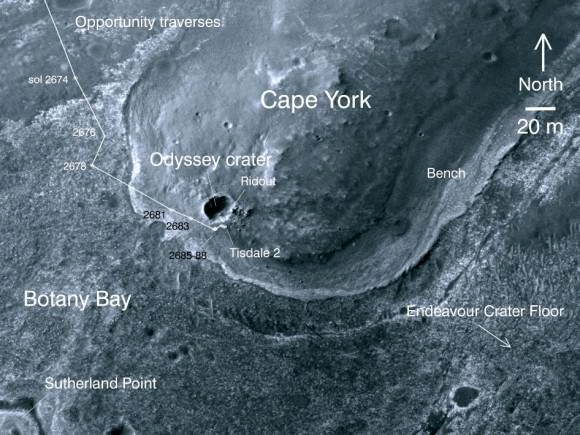
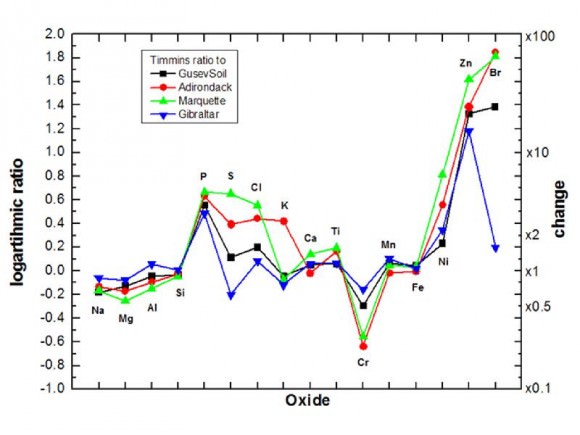
Read Ken’s continuing features about Mars starting here
Opportunity Arrives at Huge Martian Crater with Superb Science and Scenic Outlook
Opportunity Snaps Gorgeous Vistas nearing the Foothills of Giant Endeavour Crater
Dramatic New NASA Animation Depicts Next Mars Rover in Action
Opportunity Rover Heads for Spirit Point to Honor Dead Martian Sister; Science Team Tributes
Opportunity Rover Completes Exploration of fascinating Santa Maria Crater
Opportunity Surpasses 30 KM Driving and Snaps Skylab Crater in 3 D

